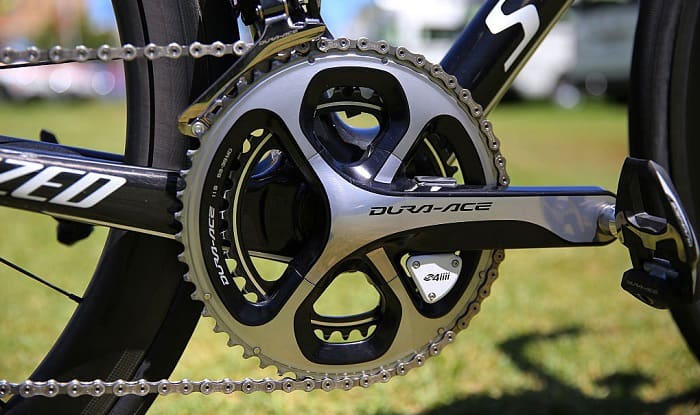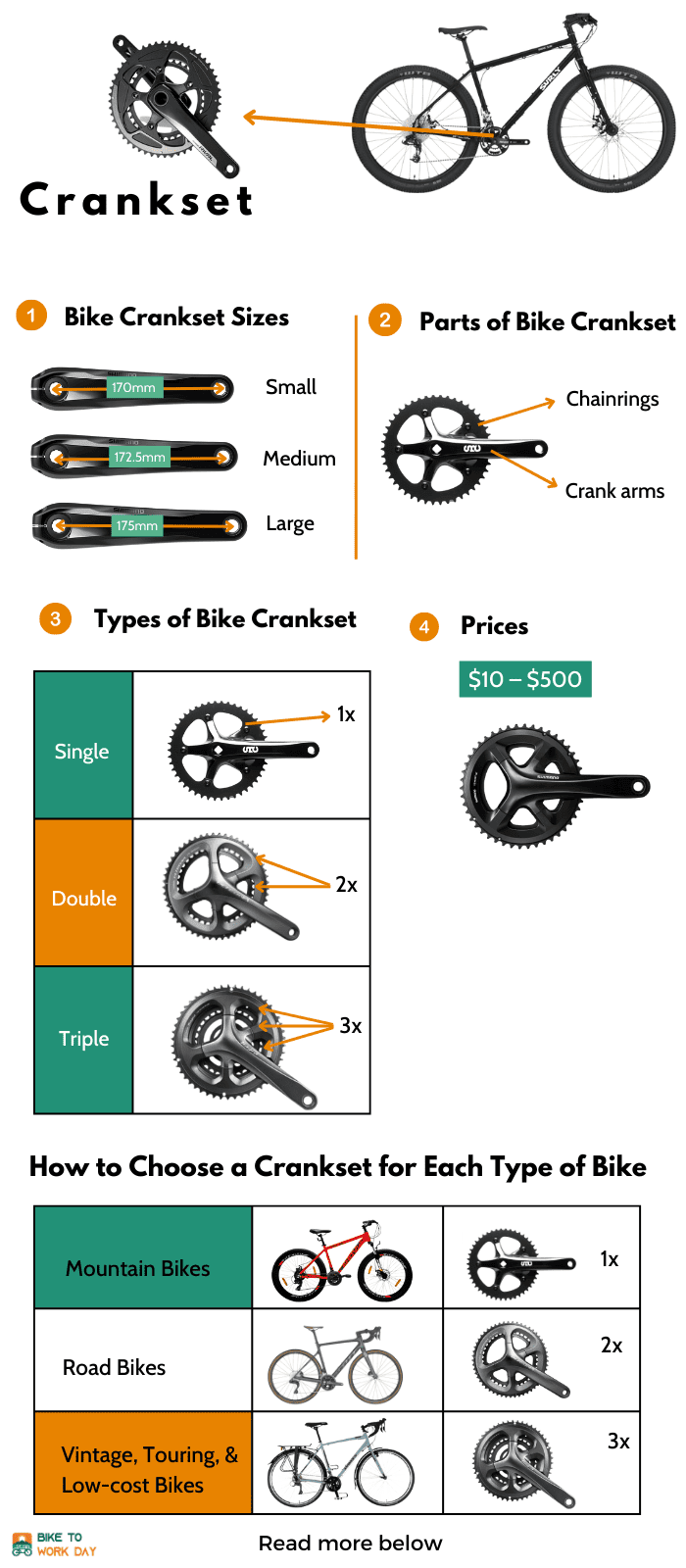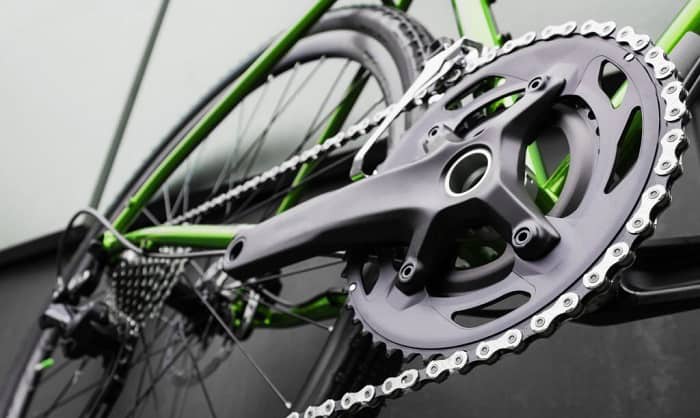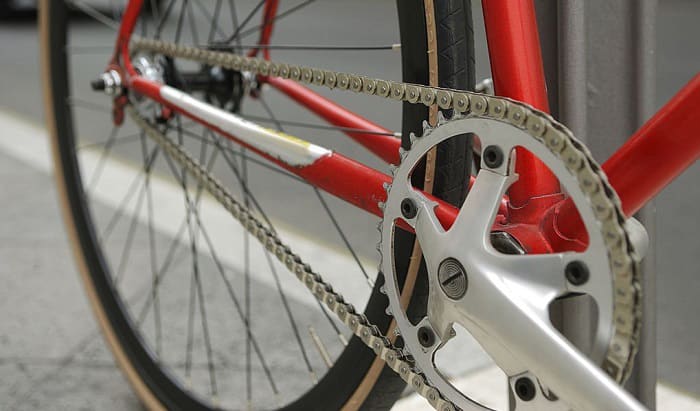A bike consists of many parts integrated to help it function accordingly. But, out of all the elements this machine has, one of the most important is a component called a ‘crankset.’
So what is the crankset on a bike exactly? The crankset is a significant bicycle part that helps you move your bike forward. Also known as chainset, this particular part in the bike drivetrain moves the chain as you pedal.
In this article, learn everything and anything you need to know about bike cranksets.
Table of Contents
Bike Crankset Explained
A crankset (or commonly referred as cranks) is an essential part of your bike’s mechanism that allows you to move the bike using the pedal.
The component converts the reciprocating motion generated by the bicycle rider into rotational motion that operates the chain, which then propels the rear wheel.
1. Chainset vs Crankset
Alternatively, terms referring to bike crankset varies per region. In North America, the component is called a ‘crankset’ while the term ‘chainset’ is common in the UK.
2. Bike Crankset Sizes
The bicycle frame build determines which size of cranks on a bike should be. There are three standard crank lengths for various types:
- Small frames come with 170mm cranks
- Medium with 172.5mm
- Large with 175mm.
However, bike parts manufacturers like Shimano and Sinz offer road bicycle cranksets of 165mm to 180mm in length per groupset level. Several specialist brands, such as Origin 8 and Sinz, offer crank options as short as 115mm.
Identifying the correct crankset size has considerable benefits that would improve your cycling efficiency.
3. Parts of Bike Crankset
A bicycle crank set comprises two parts that help to cycle your bike: the crank arms and chainrings.
Both of which functions as an integral aspect of the bike transmission system. The crank arms are attached to the pedal and between the crankset gearing, where the bicycle chains run over.
4. Types of Bike Crankset
There are three primary types of cranksets: single, double, and triple variations.
- Single – A single-ring crankset with only one chainring. The 1x crankset technology is available on a mountain bike due to its operational convenience, which is suitable for off-road riding.
As a result, there are fewer moving components and fewer locations for mud to collect.
- Double – A crankset road bike setup uses 2x crankset technology. It consists of two chainrings, the big ring (outer) and the small gear (inner).
According to the road riding terrain and rider fitness, this type of crankset comes in varying sizes.
- Triple – A three-ring crankset typically found on vintage, touring, or less expensive bikes. It is an earlier crankset version technology that provides a wide range of gears.
The three-ring system provides bike support by adding weight with the “granny ring,” beneficial for beginners on challenging climbs.
5. Prices
Since there are different cranksets for each bicycle type, market prices of cranksets differ per material and brand manufacturer.
A crankset shimano for example ranges from $20 – $500 per component. However, there are cheaper alternatives available in the market for about $10 – $200 per piece.
How to Choose a Crankset for Each Type of Bike
Each bicycle build has a designated crankset type that works to give riders optimal performance. Here is the crankset type for each bicycle build that you can choose from:
- Mountain Bikes – Mountain bicycles employ single crankset technology. With the single-ring crankset, there are fewer moving components in the machine.
It provides a lighter bicycle weight advantageous for mountain bike riders climbing on specific terrains. Also, fewer adjustments are needed without the front derailleur and shifter, making the bike ride noncomplex.
- Road Bikes – It is common for road bikes to come with double crankset technology. Riders can maintain a constant tempo with the variety of gears provided by the double crankset, which has minimal increments between each pedaling speed.
- Vintage, Touring, & Low-cost Bikes – The triple crankset technology is often available in vintage, touring, & low-cost bikes. Considered obsolete, most inexpensive mountain bikes use the 3x crankset option as an alternative.
Although outdated, for many cyclists, a triple chainset offers options that would let you ride in various situations and weather. The closer gear ratios of triple chainsets compared to single chainsets simplify gear changes, which increase the efficacy of individual performance.
FAQs
What does a bicycle crank do?
Found on the heart of the bicycle drivetrain, cranks on a bike is a collective term that refers to the component between the pedals that drives the bicycle forward.
A bicycle crank transforms the bicycle rider’s reciprocating motion into a rotating movement that drives the chain, which subsequently moves the wheel, allowing you to proceed in your desired direction.
How do I know what crankset I need?
The three factors to consider when choosing the optimal crank length you need are your height, cycling discipline, and preference. Determining the following will help you gauge the apt crank to use for your bicycle needs.
Changing your crank length means adjustments to your bike ride. By following this size chart guide, you can measure what crank length would work best for you:
| Height | Crank Length |
| 165 cm | 160 mm |
| 170 cm | 165 mm |
| 175 cm | 170 mm |
| 178 cm | 172.5 mm |
| 180 cm | 175 mm |
| 182.8 cm | 177.5 mm |
What does a crankset attach to?
Bottom brackets connect cranksets to bicycle frames. Choosing a compatible crankset
with your present bottom bracket type is essential if you will replace your entire crankset.
Since most bottom bracket and crank types need special equipment to be removed and installed, you can ask for assistance from bicycle professionals who will help you classify what kind of bottom bracket you have and how you should use the tools on hand.
When should crankset be replaced?
Replacing a bicycle crankset is needed whenever you discern signs of wearing and tearing on your component. Some indicators are knocking noises, a visible bent, or damage that could mean you have to purchase a newer one.
Are Bicycle Cranks Interchangeable?
Having thoughts if can you use any crankset on a bike? The short answer is yes.
Replacing your crankset’s chainrings is possible, but not all gears fit all types. The arms or direct-mount interfaces (which join the cranks to the chainrings) may vary between different cranksets and component positioning.
It is why it’s valuable to find and choose a bicycle crank apt to your machine’s build.
Conclusion
One of the salient elements that make a bicycle one is the crankset. Located between the pedals, it drives the bike forward using the chainrings to convert your generated motion into a moving mechanism that powers your wheels to move accordingly.
Not all cranksets work for each bike type. Determining the three factors in choosing what crank type fits your need will help you assess the best crankset that will give you optimal performance at the best speed.
We hope you found the answer you’ve been looking for in the question, “what is the crankset on a bike?”
Stay safe!

“I ride my bike to work for years, but is that enough? Our carelessness towards our surroundings has taken a toll on the environment. And now, everyone is responsible for changes; even the most minor contribution is counted. With this hope and spirit, I started with my partner to establish Biketoworkday to help more individuals commute to their work sites on their bikes.”




